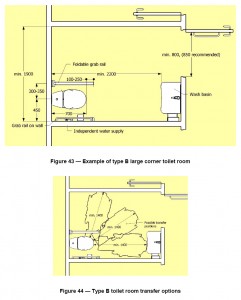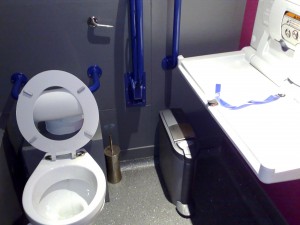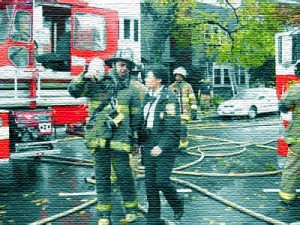2009-11-25: In 2008, the World Health Organization (WHO) Report: ‘Older People in Emergencies – Considerations for Action & Policy Development’ was published.
The following are short extracts from that Report …
Older People
Until recently, older peoples’ needs in disasters and conflicts were addressed only by broader adult health and humanitarian programmes. This has changed, as several recent emergencies highlighted this population’s vulnerabilities. Of the 14,800 deaths in France during the 2003 heat wave, 70% were people over 75 years of age. Of the estimated 1,330 people who died in the wake of Hurricane Katrina, most were older people. In Louisiana, 71% of those who died were older than 60 years; 47% of this group were over 77 years old. Worldwide, the United Nations High Commissioner for Refugees (UNHCR) has estimated that older people make up 8.5% of the overall refugee population, and in some cases comprise more than 30% of caseloads. In 2005, approximately 2.7 million people over the age of 60 were living as refugees or internally displaced persons.
Globally, the proportion of older people is growing faster than any other age group. In 2000 one in ten, or about 600 million, people were 60 years of age or older. By 2025, this figure is expected to reach 1.2 billion people, and in 2050 around 1.9 billion. In developing countries, where 80% of older people live, the proportion of those over 60 years old in 2025 will increase from 7% to 12%. Moreover, life expectancy at birth has increased globally from 48 years in 1955 to 65 in 1995, and is projected to reach 73 in 2025. By 2050, people over 80 years old are expected to account for 4% of the world’s population, up from 1% today.
Disability & Older People
Worldwide, it is estimated that more than 80% of the disabled population lives in developing countries, where the prevalence of disability is approximately 20%. That rate is expected to increase dramatically as populations age. By 2050 in India, the incidence of disability is expected to jump by 120%, in China by 70% and in sub-Saharan Africa by 257%.
Emergency Planners must consider these trends, because poor health and reduced mobility increase the risk of serious injury and illness in disasters. Older people have sustained more injuries in disasters than other groups because of functional limitations such as poor balance, muscle weakness and exhaustion. Older people have higher rates of coronary heart disease, diabetes, stroke, cancer, respiratory diseases and rheumatism. A study in China found that 74% of those over 80 years old had chronic diseases, 1.5% were physically disabled, and 3.46% had Alzheimer’s disease. In Iraq, more than half of 340 older people surveyed by HelpAge International had chronic joint and bone problems, hypertension, heart problems, diabetes and reduced eyesight and hearing. In West Darfur, Sudan, 34% of surveyed refugees 50 years of age and over were disabled, 27% could not move without help and 19% had severely impaired vision; while 61% reported chronic diseases that required specialized treatment and/or medicines that were not available.
Objective 1: Increase Visibility and Raise Awareness among Health Agencies and Humanitarian Organizations about Older Peoples’ Needs and Priorities in Emergencies.
- Mainstream and integrate issues related to older people and emergencies into existing policies and guidelines (i.e. emergency medicine, nutrition, protection, gender-based violence, participatory assessments and programming). Include plans for older people in national policy and guideline documents.
- Highlight the need to assist and protect older people as well as their capacities and contributions in rebuilding affected communities.
- Develop inter-agency efforts to identify gaps, develop practice guidelines and provide training and education.
- Promote better practice policies and documents among all stakeholders.
- Collaborate with funders to increase humanitarian assistance to older people based on needs assessments and reflect these in funding proposal criteria.
- Involve older people in developing emergency management activities to increase their visibility and ensure their needs are taken into account, for example, in shelter plans and locations.
Objective 2: Develop Essential Medical and Health Resources for Older People in Emergency Practices.
- Identify and include essential medicines for older people in emergency kits. Include medicines for chronic diseases and other illnesses common among this social group.
- Develop disability aid packages with equipment such as eyeglasses and walking sticks.
- Develop education modules for health professionals on diseases common among older people, including HIV/AIDS.
- Develop and disseminate guidelines for geriatric medicine in emergencies and humanitarian crises.
- Within the health care system, ensure that conditions and needs common to older people are integrated into patient triage, clinical evaluation, treatment, the emergency medical response system and access to specialty care.
- Ensure that nutritional guidelines for food distribution suitable for older people are integrated into health planning and response plans.
- Ensure local development of guidelines for feeding older people, using locally available foods to the extent this is possible where populations depend on external food aid.
- Implement gender-based analyses in planning and programme design to account for differences between older men and women in terms of both health needs and access issues.
Objective 3: Develop Emergency Management Policies and Tools to Address Older Peoples’ Health-Related Vulnerabilities.
- Integrate older peoples’ health needs and related issues into assessment tools and practices.
- Develop community-based tools using disaggregated data to identify vulnerable older people. Include formats to identify chronic health conditions, disabilities and nutritional needs.
- Develop procedures to identify hidden and stay-behind older people.
- Develop standardized tools to assess support needs of older people, including inter-generational and community care options.
- Develop age-friendly standards and guidelines so that service and care environments are accessible to older people with disabilities.
- In collaboration with older people, their families and communities, develop personal and household preparedness kits in areas of predictable disasters.
- Collaborate with communities in identifying and implementing community-based home care and support strategies which may reduce older peoples’ isolation and vulnerability during crises.
- Develop guidelines and evacuation plans that include mechanisms to identify and transport frail, disabled and older people with special medical conditions. Identify procedures to ensure adequate care and treatment as necessary.
- Develop guidelines to ensure safe and adequate treatment of older people in evacuation centres and refugee camps.
- Ensure that health facilities have feasible plans to care for older people during disasters and humanitarian crises.
- Develop monitoring and evaluation tools to measure the performance of health care services and humanitarian interventions targeting older people. These measures should be integrated into existing monitoring and evaluation procedures where possible.
Objective 4: Ensure that Older People are Aware of and Have Access to Essential Emergency Health Care Services.
- Use established assessment tools to identify and locate frail and disabled older people and those with chronic diseases and special medical conditions, as well as older caretakers of orphaned children.
- Ensure that assessments are participatory and target all older populations. Assessments should include information on health conditions, social support needs, caretaking responsibilities and available means to meet basic living needs, including access to food and health services, treatment and medicines.
- Ensure that assessments are coordinated across primary health care, rehabilitation, long term care and social services to meet the needs of older people.
- Implement outreach services and referral mechanisms to identify and ensure care for hidden or stay-behind older people.
- Coordinate primary health care, rehabilitation, long-term care and social services to establish system referral mechanisms that older clients may require.
- Assess and organize training for health staff to ensure knowledge of geriatric nutritional, health and medical care needs.
- Establish information programmes to educate older people, families and caregivers about nutritional needs, medical conditions and health care options.
- Use disaggregated data to assess services by age and gender.
Objective 5: Provide Age-Sensitive and Appropriate Health and Humanitarian Services to Maintain Older Peoples’ Health.
- Ensure that equitable access to shelter, clothing, food and sanitation prevent deterioration of health through integrated individual assessments and referrals to health and humanitarian agencies.
- Ensure that age-friendly practices are used to promote services to older people with disabilities.
- Provide access to appropriate health care, including medicines for chronic diseases and disability/restorative aids.
- Collaborate with communities in identifying community-based home care and support options for frail and disabled older people.
- When appropriate and feasible, develop mobile clinics to extend health services to older people living in remote locations.
- Implement mechanisms to assess nutritional balance and ensure access to supplementary food programmes when appropriate, taking into account that many older people also care for children. Provide education on food preparation using supplementary or locally available foods.
- Ensure that protection needs of older people are integrated into programming (e.g. social welfare or community services) to identify persons at risk and prevent abuse and exploitation.
- Undertake monitoring to assess continuing effectiveness of services to older people.
- Use disaggregated data to assess efficiency of implemented activities by age and gender.
Objective 6: Promote Cross-Sectoral Planning and Co-Ordination to Raise Awareness of Older Peoples’ Needs in Crises and Reduce Their Risk of Marginalization and Deteriorating Health in Emergencies.
- Raise awareness among agencies and organizations concerning physical and health issues specific to older people and of ways to adapt basic need support to their requirements (e.g. supplementary food rations, livelihood needs and impacts of protection issues on older peoples’ physical and psychological health).
- Where possible, include older people in planning and programming committees to increase their visibility and ensure their needs and priorities are integrated.
- In coordination with appropriate partners, establish community self-help groups to facilitate community care for more vulnerable older people.
- Recognize self-sufficiency as key to maintaining health and encourage the inclusion of older people in training programmes, income-generation schemes, and community development projects.
- Establish older peoples’ committees to facilitate self-advocacy and communication with authorities and ministries of health to increase access to existing services and entitlements.
Objective 7: Build Institutional Capacity and Commitment towards Ensuring the Health and Safety of Older People in Emergencies.
- Integrate cross-cutting health emergency management issues into global/regional/country strategic plans.
- Promote inter-agency and cross-sectoral consultation on cross-cutting policy and programming issues to build consensus, commitment and capacity to respond to older peoples’ needs in disasters and humanitarian crises.
- Collaborate with ministries of health to establish mandates and legislation ensuring the provision of care to older people; apply a human rights framework to these issues.
- Collaborate with ministries of health to develop options to increase older peoples’ access to affordable health care services, including the implementation of subsidized medical and medicine programmes.
- Advocate for enhanced funding and humanitarian assistance to older people in emergencies and conflicts. Encourage funding agencies to recognize older people as a priority.
- Develop frameworks to promote participatory, transparent and accountable processes to advance the needs of older people.
- Develop sustainable mechanisms to maintain advocacy and consultation of older people within the health care-system. Establish and involve advocacy committees in the planning, implementation and evaluation of emergency management practices when appropriate, for example regarding the design of community shelters that may be accessed by older disabled people.
Objective 8: Strengthen the Capacity of Ministries of Health and Health Care Systems to Meet the Needs of Older People in Emergencies.
- As required, integrate the medical and nutritional needs of older people into local public health and emergency preparedness and response strategies.
- Develop strategies to ensure that existing health care systems develop capacity (infrastructure and knowledge) to meet the increasing proportion of older people who will be impacted by disasters in the future, taking into account medical, disability and mental health needs, including dementia and Alzheimer’s disease.
- Collaborate with communities in identifying community-based home care and support strategies for older people as an option to reduce older peoples’ isolation and vulnerability to disasters.
- Collaborate with communities to develop and maintain disaster reduction committees. Assist in the implementation of strategies to strengthen community support to older people and reduce their levels of risk during disasters (e.g. development of community emergency response teams or mutual assistance groups among more vulnerable older people).
- Integrate older peoples’ needs into exercise designs and facilitate the dissemination of lessons learned.
- Develop performance frameworks and monitoring mechanisms to assess medical response systems and older peoples’ access to specialty care in emergencies.
Objective 9: Develop Mechanisms to Ensure Continuing Development and Exchange of Expertise as these Relate to Older People in Emergencies.
- Develop and provide ongoing training and education to staff on the needs and priorities of older people, including responsibility to include this population in planning and policy development.
- Integrate issues related to older people in emergencies into relevant university curricula.
- Undertake comparative research to assess the health status (including access to assistance) of older people in emergencies vis-à-vis other age groups.
- Undertake research to address demographic shifts and the increasing proportion of older people in disasters as this relates to health care and infrastructure/facility development.
- Ensure emergency preparedness and response considerations are integrated into relevant services and institutions (e.g. facilities caring for frail and disabled older people are required to develop and practice evacuation and emergency care plans).
Objective 10: Promote Active Ageing as a Strategy to Reduce Vulnerability and Develop Resiliency to Disasters.
- Promote a wider understanding among ministries of health and humanitarian organizations of the economic and social factors contributing to the vulnerability of older people, including issues related to livelihoods, inter-generational dependence and social pension.
- Develop policies that recognize active ageing and resiliency as facilitating older peoples’ capacity to prepare for, cope with and respond to the affects of disasters and conflicts.
- Include a life course perspective that recognizes health promotion and prevention of disease and disability.
- Support cross-sectoral forums and activities which link the risks of older people in emergencies to frameworks for livelihoods, protection and gender-based equality, health promotion and social pension.
- Collaborate with relevant organizations to mainstream the health needs of older people into existing humanitarian programmes addressing shelter, nutrition, livelihoods, protection and gender-based violence.
- Develop information campaigns and encourage media to highlight both the needs and capacities of older people and to increase their visibility.
- Collaborate with funding bodies to integrate active ageing as a criterion in funding proposals targeting older people.
.
.
END












